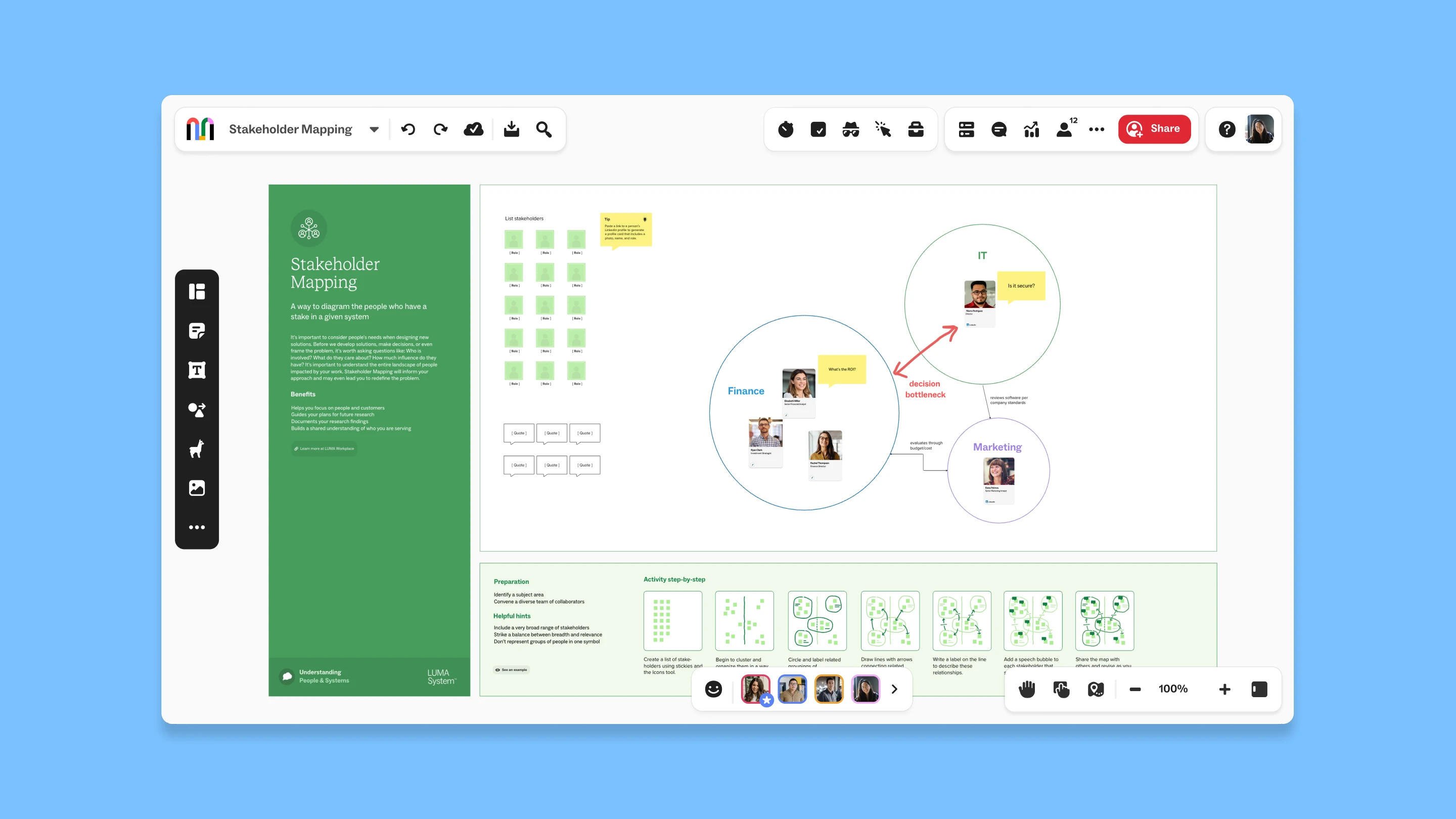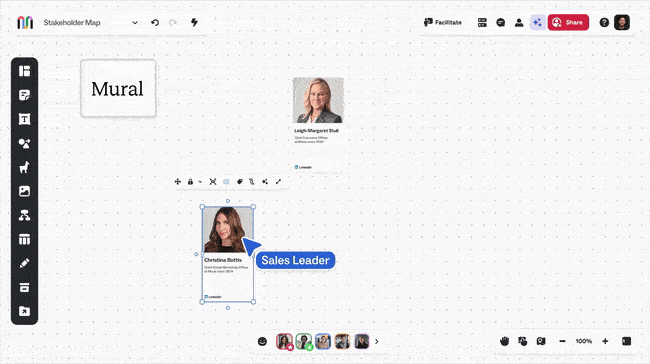As teams within larger organizations become more empowered to make decisions and drive innovation, documentation and generating buy-in take on increasingly important roles. This is where a stakeholder analysis comes into play.
Stakeholder maps outline the context for what the project stakeholders are, their level of influence, which key players are responsible for decision-making, and they provide a visual representation of how these all connect into a larger engagement strategy.
When developing new ideas, kicking off a new project, or building new products, it's important to consider who will be involved, who will be affected, and to what extent. In this guide, we'll cover:
- What is stakeholder mapping?
- Why is stakeholder mapping important?
- Common types of stakeholders
- Methods for mapping stakeholders
- A step-by-step guide for mapping stakeholders
Let’s get started!
What is stakeholder mapping?
A stakeholder map is a visual representation of individuals or groups with a vested interest in a project, product, or idea. Stakeholder mapping helps you identify these key stakeholders, understand their influence, and develop a strategy for stakeholder management.
Depending on your project, your list of stakeholders might include clients, collaborators, project owners, or even end-users of a product.
Why is stakeholder mapping important?
Creating a map of your stakeholders helps you identify key partners, understand how they will influence your project, and create a plan for how they should be involved and managed throughout the process.
This information can be used to develop a communication and engagement plan that meets everyone’s needs and helps you more effectively manage stakeholder expectations and ensure your project’s success.
By aligning stakeholders with their respective roles and responsibilities, organizations can create a framework for stakeholder engagement that is both effective and efficient. Additionally, stakeholder mapping can help to identify potential areas of conflict and misunderstanding, allowing organizations to address these issues before they become major problems.
Stakeholder mapping is a valuable tool that can help organizations to improve stakeholder communication and build team alignment.
When do I need a stakeholder map?
When developing new products, kicking off a new project, or building new features, it's important to consider who will be involved, who will be affected, and to what extent. Stakeholder management is a helpful tool to have during the project discovery, implementation and review phases of a project, making it instrumental for collaborative project management.
For example, if you're developing a new employee portal, you'll need to map out the relationships between HR or People Operations, IT, and the employees who will be using the portal.
What are the types of stakeholders?
There are a few different ways to group stakeholders, so we recommend using whichever method works best for your use case. The main ways you can categorize stakeholders are by level of influence, involvement, and proximity to the work being done.
Pro-tip: The stakeholder mapping template appearing later in this article prioritizes your stakeholders by interest and influence.
Stakeholder influence
When grouping stakeholder by influence, there are four main types of stakeholders: primary, secondary, tertiary, and quaternary:
- Primary stakeholders are those who have a direct impact — or high power — on the product or project (e.g. employees, customers).
- Secondary stakeholders are those who have an indirect impact on the product or project (e.g. shareholders).
- Tertiary stakeholders are those who have a potential impact on the product or project (e.g. industry experts).
- Quaternary stakeholders are those who have no direct impact — or low power — on the product or project but may be interested in its success or failure (e.g. media).
It's important to consider all four types of stakeholders when developing your map; however, primary and secondary stakeholders should be given special attention as they have the most direct impact on your product or project.
Stakeholder interest
Grouping stakeholders by level of interest (or involvement) can help you understand and prioritize the stakeholders you’ll be working with most closely. These are the three levels of stakeholder involvement:
- High-involvement stakeholders are those who have a significant interest in your project or organization and who could be significantly impacted by its success or failure.
- Medium-involvement stakeholders are those who have some interest in your project or organization but who are not as invested as high-involvement stakeholders.
- Low-involvement stakeholders are those who have little interest in your project or organization and who are not likely to be affected by its success or failure.
Internal vs. external stakeholders
Internal stakeholders and external stakeholders are two different categories of individuals or groups who are affected by an organization or project. The main difference between the two is their relationship with the organization or project.
Internal stakeholders
Internal stakeholders are team members or groups who are directly related to the organization or project, and are typically involved in its day-to-day operations or decision-making processes. Internal stakeholders have a vested interest in the success of the organization or project, and their involvement is crucial to its achievement.
Internal stakeholders may include employees, managers, board members, and shareholders.
External stakeholders
External stakeholders, on the other hand, are individuals or groups who are not directly related to the organization or project, but are affected by its actions and decisions. External stakeholders have a varying degree of influence on the organization or project, and their involvement can have a significant impact on its success or failure.
External stakeholders can include customers, suppliers, regulatory agencies, community groups, and the general public.
How do you map the relationships between stakeholders?
Once you've identified all of your potential stakeholders, it's time to start mapping out their relationships with each other.
The basic components of a stakeholder map include a framework, evaluation criteria, your stakeholders, and how they’re involved. You can also include any additional information relevant to your specific project.
There are two main ways to do this: by using a grid system or by creating a network diagram. Learn more about these below:
Grid stakeholder map
A grid system is best for large projects with many stakeholders; it allows you to see all of the relationships at a glance and identify any potential conflicts early on in the process.
This can be helpful to determine each stakeholder’s level of interest or involvement. Try to organize stakeholders from high interest to low interest to guide your communication plan.
Network diagram
A network diagram is best for smaller projects with fewer stakeholders; it provides a more detailed look at how each stakeholder interacts with others and how they might be impacted by changes throughout the process.
Stakeholder map example
Below is a template for stakeholder mapping, with three key components:
- An area for brainstorming who your stakeholders are
- An interest vs. influence matrix that allows you to plot all your stakeholders across four quadrants: Monitor, Actively Engaged, Keep Informed, and Keep Satisfied
- A visual of your stakeholder map, with the new product or feature at the center and the various levels of stakeholders radiating outward from the middle.

How to create a stakeholder map in six steps
1. Define the purpose of the stakeholder map.
The first step in creating a stakeholder map is to define the purpose of the map. Are you creating a new product or feature? Are you preparing to enter a new market or niche within your existing market? What information do you want to include? Once you have a clear idea of the purpose of the map, you can move on to the next step.
2. Brainstorm and identify who your stakeholders are.
The next step is to identify who your stakeholders are, which means it’s time to brainstorm with your team. A stakeholder is any individual or group that has an interest in your project or organization. When identifying your stakeholders, it is important to think carefully about everyone potentially involved, at every stage of the process — and that means both internal and external stakeholders.
Remember: Internal stakeholders are individuals or groups within your organization, while external stakeholders are those outside of your organization.
3. Add LinkedIn URLs to create a company profile cards.
Paste a LinkedIn URL into your mural to instantly create a company profile card. Then, use custom tags and color bars to visually organize stakeholders into categories.

4. Determine what level of involvement each stakeholder has.
Once you have identified your stakeholders, you need to determine what level of involvement each one has, and at what stages of the project. As a refresher, there are three levels of involvement: high, medium, and low.
For example, in this Mural stakeholder mapping template built by the LUMA Institute, we use the radar approach to map not only the level of involvement but also the connection between stakeholders.
Think carefully about which buckets each stakeholder belongs in, keeping in mind that high-involvement stakeholders may be external to your organization, while low-involvement stakeholders may be your colleagues, depending on the nature of the project. Use Mural AI to generate, cluster, and summarize next steps faster.
5. Identify each stakeholder's interests and goals.
The next step is to identify each stakeholder's interests and goals. What does each stakeholder stand to gain from your project? What are their goals? What are their main concerns or issues that could get in the way? How might different stakeholders have competing priorities?
Once you have identified these areas of interest and specific goals, you can begin to think about how best to engage with each stakeholder.
6. Develop an engagement plan.
The final step is to develop a plan for engagement. How will you engage with each stakeholder as you develop your map and begin your project? What communication channels will you use? What type of information will you share? Once you have developed an engagement plan, you can begin implementing it and working towards achieving your goals.
The bottom line
Stakeholder maps provide the necessary documentation to effectively communicate thought processes, plans, and analyses in both directions (whether asynchronously or in real time), ensuring that leadership understands the reasoning behind new product or feature development, as do the employees tasked with carrying out the individual tasks.
This is why stakeholder mapping is an essential tool for any Scrum master, Agile coach, consultant, or project leader looking to foster high-impact innovation and ensure successful execution of their product development plans.
Stakeholder mapping steps:
- Define the purpose of your stakeholder map — what belongs in the center?
- Brainstorm to build your list of stakeholders
- Determine each stakeholder’s level of involvement
- Determine each stakeholder’s interests and goals
- Build an engagement plan based on stakeholder personas
By taking the time to map out all of your stakeholders and their relationships with each other, you can create a communication and engagement plan that meets everyone's needs, ensuring smooth sailing from start to finish!
Build a free stakeholder map with Mural
Mural is the visual work platform that allows all kinds of teams to do better work together — from anywhere. Team members get aligned faster with templates, prompts, and proven methods that guide them to quickly solve any problem. They can gather their ideas and feedback in one spot, allowing them to see the big picture of any project and act decisively.
Whether you’re looking to transform how your team works, or just get started with a stakeholder mapping tool, look no further than Mural.
Get started with one of Mural's free templates that drive empathy and understanding, included with any Free account, and invite unlimited members so that everyone on your team can participate.






.avif)






